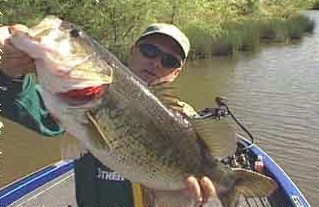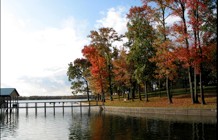Largemouth bass are the most popular sportfish on Lake Fork Reservoir. A
combination of restrictive harvest regulations, stocking of Florida
strain largemouth bass, and good habitat has contributed to Lake Fork's
development as one of the country's premier trophy bass lakes. More than
65% of the Texas Top 50 largest bass, including the current state
record, were caught from Lake Fork.
 Crappie
fishing is generally good, especially in standing timber and under the
lake's numerous bridges. Channel catfish provide an excellent sport
fishery, though this remains a well-kept secret. Sunfish, primarily
bluegill, offer additional angling opportunities during spring and
summer.
Crappie
fishing is generally good, especially in standing timber and under the
lake's numerous bridges. Channel catfish provide an excellent sport
fishery, though this remains a well-kept secret. Sunfish, primarily
bluegill, offer additional angling opportunities during spring and
summer.FISHING COVER/STRUCTURE
Flooded timber is found throughout Lake
Fork and provides excellent fish habitat. Although access through the
reservoir is provided by numerous buoyed boat lanes, submerged timber
represents a substantial hazard, so care should be exercised while
boating in all areas. Areas containing hydrilla, boat houses and docks,
and lake points have historically provided some of the best fishing for
largemouth bass.
FISHING TIPS AND TACTICS
Largemouth bass anglers are most
successful on this reservoir during the spring, fall, and winter months.
Spinnerbaits, plastic worms and lizards, jigs and jerk baits are all
popular baits during peak fishing in the spring (mid-February to April)
when fishing is concentrated along the shoreline for spawning fish.
Nightime fishing during the hot summer months can be very productive and
a good way to beat the Texas heat. At this time, plastic worms,
spinnerbaits, crankbaits and topwaters are often used. During late
summer and early fall, when fish are schooling, crankbaits and topwater
lures can be very effective. In winter jigging spoons, jigs and
crankbaits are most productive.
Crappie anglers concentrate their efforts in deep water near the
dam during the winter months. In late spring and early fall, most angler
fish for crappie under the bridges (Highway 154, Highway 515, CR 2946
and CR 514). Live minnows and crappie jigs are among the most popular
baits used. The catfish population is dominated by channel
catfish, but also includes flathead catfish. Stinkbait and cutbait work
well for channel cats, while live bait is preferred for flatheads.
Anglers occasionally catch large blue catfish.
Sunfish such as bluegill and redear can be caught in early
summer, in shallow water, using crickets, earthworms and small spinners.
During the remainder of the year they can be caught using the same baits
around piers, boathouses and submerged humps.
Location: On the Sabine River in Hopkins, Rains
and Wood Counties, 5 miles northwest of Quitman
Size: 27,680 acres
Maximum Depth: 70 feet
Date Impounded: 1980
Normal Water Clarity: Moderately clear
Water Level Fluctuation: Moderate, 2-4 ft.
Conservation Pool Elevation: 403 ft. msl
Current Water Levels
Aquatic Vegetation: Hydrilla, Eurasian milfoil,
coontail, American lotus, water primrose, water hyacinth and pennywort
ACCESS/CAMPING
The Sabine River Authority (903) 878-2262 operates four public boat
ramps and a free day use area. There are also numerous privately-owned
access and accommodation facilities in the immediate vicinity of the
lake. Accommodations range from motels and cabins to RV sites and tent
camping. Individual facilities include services such as bait and tackle
shops, convenience stores, fishing piers, gas pumps, and restaurants.
MAPS
A small map is available free of charge
from the Sabine River Authority. A number of good topographic maps are
sold by local businesses. Online topographic maps are also available.





